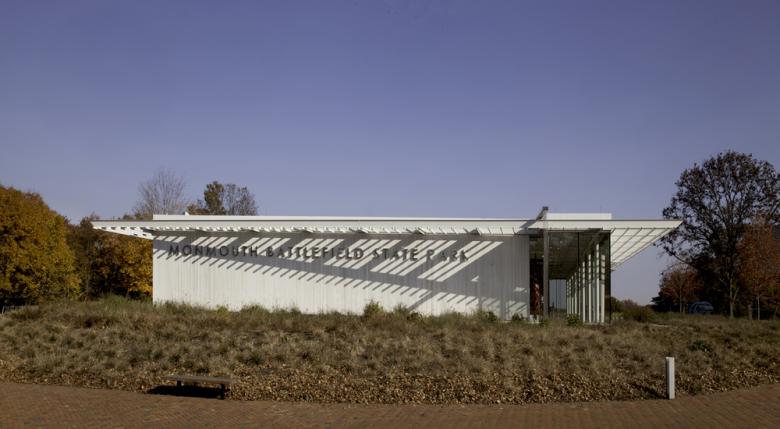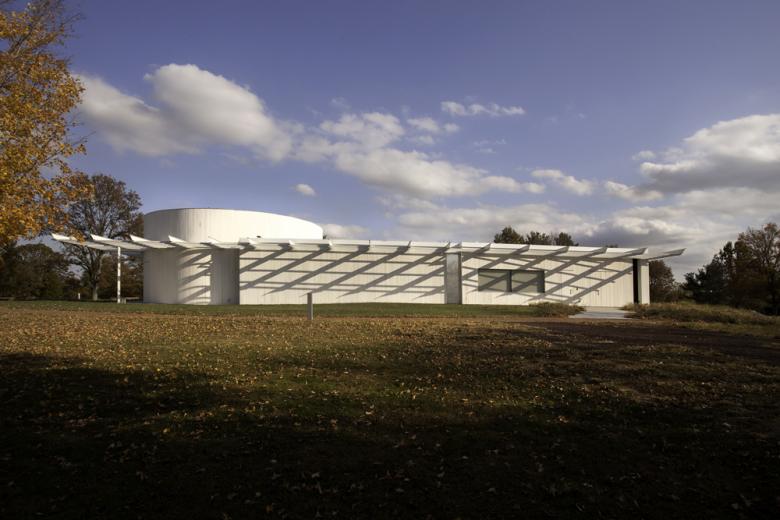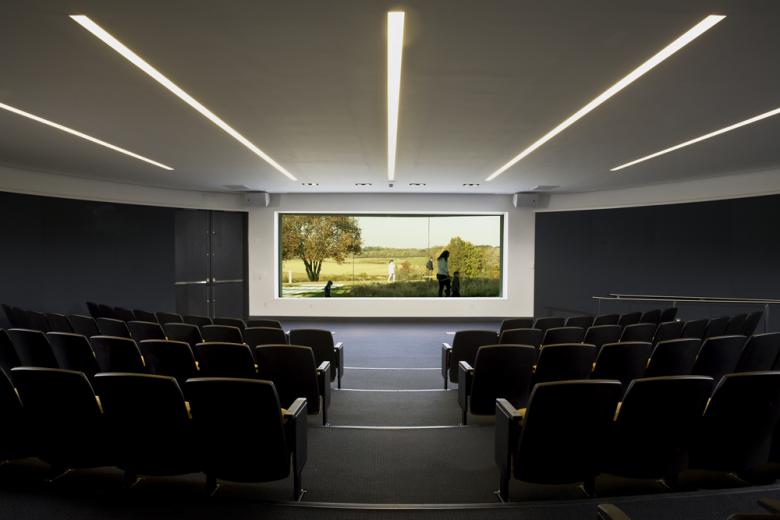Monmouth Battlefield State Park Visitor Center
28. July 2014
In the United States battlefields from the American Revolution and Civil War are considered sacred ground, preserved as open space and used as sites for education and interpretation. The American Revolution's Battle of Monmouth took place on a hot day in June 1778 in central New Jersey. The battlefield is served by a visitor center that ikon.5 architects recently renovated and expanded, orienting the new building to the site of the battle. The architects answered a few questions about the project.
View of Visitor Center from parking lot
What were the circumstances of receiving the commission for this project?
The commission for this state of New Jersey American Revolution Battlefield Visitor Center was a response to an open RFP (Request for Proposal). We submitted our qualifications and were selected to interview with five other firms. For the interview we carefully analyzed the existing site and visitor center and offered a critique on how to improve the visitor experience during an interview. We also created a short film, as part of the interview, that captured the sprint and design strategy we would employ if we were engaged.
View of new Visitor Center and existing renovated center from the battlefield
Please provide an overview of the project.
The Monmouth Battlefield State Park visitor center is a renovation and addition to the park’s existing interpretation center which welcomes and educates visitors to the longest battle of the American Revolution. This battle is considered a critical turning point in the American Revolution and is cited as one of General Washington’s brilliant political strategies thus advancing the colonist victory and his ascension to the presidency. It is the landscape of the battlefield that is the most powerful and enduring artifact of the events that lead to the colonist independence. The site for the visitor center is on top of Combs Hill, one of the high points, that overlooks the unspoiled and largely unchanged landscape of the battle. The Visitor Center houses: 8,000sf addition, 6,000sf renovation, lobby, exhibition gallery, orientation theater, museum store, administrative offices, multipurpose classrooms, archeological lab and storage, comfort station and restrooms.
View of new Visitor Center and existing renovated center from the battlefield
What are the main ideas and inspirations influencing the design of the building?
The concept for the visitor center pays homage to this heroic landscape by integrating the center into the land. The visitor center is conceived as a modern day primitive hut, a templar in its siting at the top of Combs Hill, but diminutive in its appearance. Like a floating cloud above the summit, the visitor center is a simple one story flat roofed structure that orients the visitor to the views and creates a "steel sky" of expanded metal mesh above. The mesh is a solar shade around the perimeter of the building and acts as a common expansive ceiling in the exhibition gallery which conceals lighting fixtures and acoustical treatments. The new visitor center is adjacent to the 1976 bicentennial existing Brutalist visitor center that is obsolete for contemporary interactive exhibitions. A portion of this structure is removed to make way for the new visitor center and a portion is renovated into the multipurpose classroom and archeological lab space.
View of west façade facing fields
To what extent did the clients and/or future users of the building influence the design and the outcome of the building?
The client user group greatly influenced the design and final outcome of the Visitor Center. The design committee was comprised of members from the State of New Jersey Park and Recreation, Historic Sites and Resources, as well as, the Director of the Visitor Center and interpretive specialist. Their contribution effected both the architecture and the historical context of the exhibits. Chief among these contributions is the buildings focus on the battlefield – the primary artifact of the visitor experience.
Detail view of Visitor Center and rain garden
How does the building relate to contemporary architectural trends, be it sustainability, technology, etc.?
The Visitor Center is designed as a high performance facility that will receive a USGBC LEED Silver Certification. In addition to the solar screen around the perimeter of the center, the design incorporates a number of sustainable features. The majority of the exterior of the enclosure is triple glazed low-e laminated glazing units permitting the maximum views, but minimizing heat gain and lost. The new visitor center and renovation occur within the bounds of the existing site. Land is not additionally disturbed to commence with this project. The new visitor center and renovated portions of the existing building will be heated and cooled with a geothermal system. Rain water is collected on the roof and is channeled into a rain garden feature at the entry to the visitor center. Natural grasses and flora are planted adjacent to the structure to minimize maintenance and to encourage indigenous birds and reptiles to live on top of the hill once again.
Detail view of Visitor Center overlooking the battlefield
How would you describe the architecture of New Jersey and how does the building relate to it?
The architecture of New Jersey is very diverse encompassing nearly three hundred years of settlement and influences not only of time but by the rich immigrant history of the state. Unique in its diversity are primitive early American or Colonial Structures made of local Delaware Valley field stone.
The Monmouth Battlefield Visitor Center is contemporary and abstract not making a reference or gesture to New Jersey’s past. This approach to architectural expression was purposeful in order to place focus and direction not on the meaning of the building, but on the meaning of its chief artifact – the landscape of the battlefield.
Email interview conducted by John Hill.
Interior view of gallery toward battlefield beyond
Detail interior view overlooking the battlefield
Interior view of American Revolutionary exhibits
View from inside auditorium looking out to battlefield
Site Plan
Floor Plan
Sustainability Diagram
Monmouth Battlefield State Park Visitor Center
2013
Monmouth County, New Jersey
Client
State of New Jersey
Architect
ikon.5 architects
Princeton, NJ
Design Principal
Joseph G. Tattoni, AIA
Managing Principal
Arvind Tikku, AIA
Technical Principal
Charlie Maira, AIA, LEED AP
Project Team
Michael Herbst, AIA
J. Daniel Cummings, AIA
Michael Zareva, LEED AP
Structural Engineer
Thornton Tomasetti Engineering
MEP/FP Engineer
Altieri Sebor Wieber Engineering
Landscape Architect
Argos Landscape Design
Lighting/Interior Designer
ikon.5 architects
Contractor
Patock Construction
Exhibition Design
Gallagher
Aluminum Curtain Wall System
YKK Aluminum
Solar Shade and Mesh System
AMICO Metals
Triple-Glazed Structural Glass
Berkowitz Glazing
TPO Roofing
Flex Membranes
Building Area
10,000 sf (new construction); 8,000 sf (renovation)
Photographs
James D'Addio
Drawings/Renderings
ikon.5 architects












